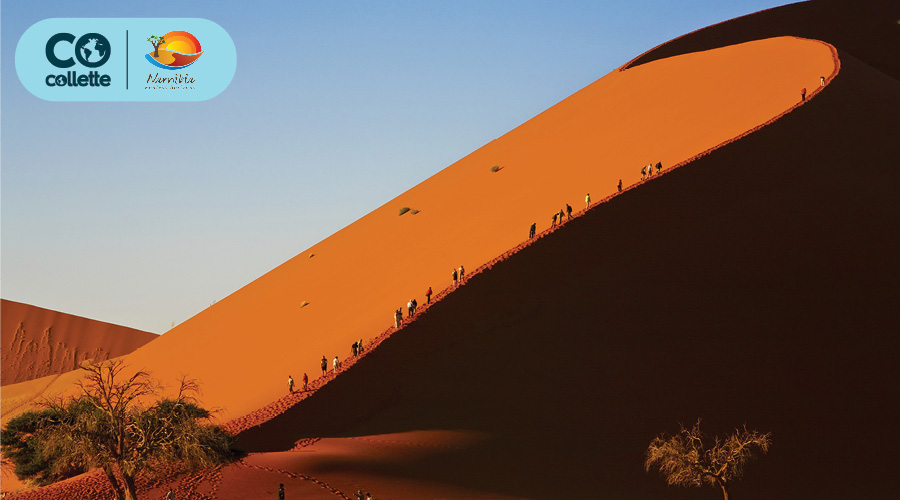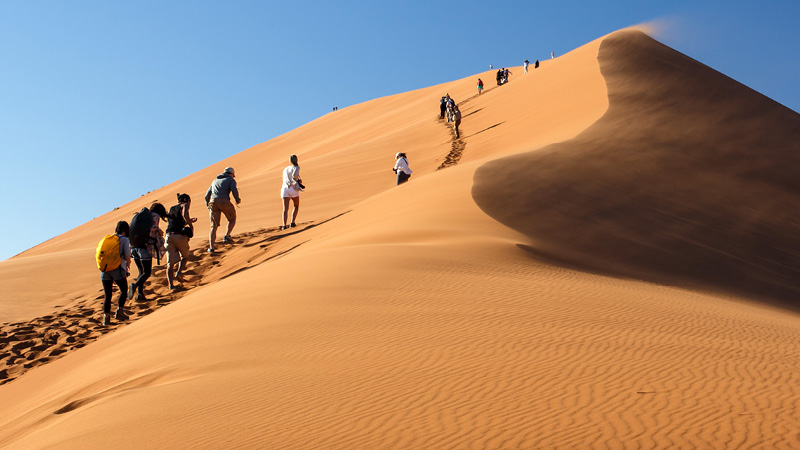
Namibia Travel in 2025: Some of the Best Things to Do and See

January 30, 2025
5 minute read
Why Travel to Namibia?
Namibia is a place of breathtaking contrasts. There are jaw-dropping landscapes that seem to belong on another planet and cities infused with European architecture. There are massive sand dunes that dominate the land and sky and small desert animals that enchant with their mere presence. There are the untouched expanses crafted by nature and the rich cultural tapestry woven by the people who call Namibia home.
Tucked against Africa’s west coast, one of the continent’s youngest countries beckons those with a thirst for adventure and a passion for exploring the planet’s wonders. If you have yet to consider Namibia as a safari or travel destination, it might just belong on your bucket list.

5 Incredible Things to Do in Namibia
1. Go on Safari in Etosha National Park
Etosha National Park competes with other top safari destinations, offering up great wildlife viewing opportunities, especially at its watering holes. It’s also home to four of the “Big Five”: elephants, lions, leopards, and rhinos. But what really sets this national park apart is its unique safari setting. The word “Etosha” roughly translates to “great white place,” a meaning linked to the salt pan that covers almost 25% of the park’s land—and is so massive, it can be seen from space.
2. Visit the Skeleton Coast
Extending south from Namibia’s Angolan border, the Skeleton Coast stretches across 300 miles of coastline—and it’s swallowed over 1,000 ships. With its treacherous currents, strong winds, and heavy surf, it’s a notorious shipwreck graveyard. All this, combined with its rugged and harsh landscapes, make the national park there a fascinating area to explore.

3. Wonder at the Namib Desert
The Skeleton Coast is a highlight of its own, but it also marks the border of another marvel: the Namib Desert. Otherworldly landscapes and desert-adapted wildlife elevate this expanse of land far beyond your textbook definition “desert.” It’s a place that astounds with its sheer enormity, mountainous dunes, and intriguing features. Gaze at a lunar-like landscape at Moon Valley. Stand before some of the tallest dunes in the world at Sossusvlei, and visit nearby Deadvlei to see the scene painted by skeletal trees, a white clay pan, and striking red sand.
4. Get to Know Local Cities
Namibia is a place of impressive landscapes and wildlife, but its cities also hold plenty of charms. Located right in the middle of the country, Windhoek, the capital city, is a modern hub amidst Namibia’s vast wilderness. Travel west from Windhoek and you’ll arrive in Swakopmund, a popular beach resort city nestled by the sea just below the Skeleton Coast. There, you’ll find plenty of outdoor activities, streets lined with German colonial architecture, and a desert oasis-type feel.

5. Search for Marine Life in Walvis Bay
Land isn’t the only place to see the animal kingdom in Namibia. Just south of Swakopmund, Walvis Bay—which is the name of both a city and the bay beside it—is home to a variety of marine life and birds. Set out on a marine cruise, and you might catch a glimpse of whales and dolphins breaching the water. A narrow peninsula named Pelican Point is one of the area’s highlights, known to host seals, pink flamingos, and (you guessed it) pelicans.
What You Should Know About Travelling to Namibia
The Best Time of Year to Travel to Namibia
The best time to travel to Namibia ultimately depends on your priorities and where in the country you’re going. Namibia’s dry season, which runs from around May to October, generally comes with warm, sunny days and cooler (and sometimes cold) nights. This time of year makes for great game viewing on safari, as animals tend to congregate around watering holes. The wet season can mean heat, humidity, and afternoon thundershowers.
What to Pack for Namibia
Ultimately, your packing list depends on where you’re going, when you’re travelling, and what activities you plan to do. There can be great swings between daytime and nighttime temperatures, so lightweight cotton shorts, slacks, and shirts, as well as hats and jackets or sweatshirts might all have a place in your suitcase. For safari, think neutral colours for game drives, and remember that white items can easily get dirt on them. Mosquito spray can also come in handy. Be sure to research your trip to be fully prepared.

Travel to Namibia, Africa on a Guided Collette Tour
From the wonders of the Namib Desert to game drives in Etosha National Park, there is so much to see and do in Namibia. Experience it on Collette’s small group Namibia & South Africa: Epic Landscapes & Wildlife tour, and let our experts guide you through an adventure spanning two countries. Five wildlife safaris, cultural connections, epic landscapes, and more are waiting.
To learn more about this Small Group Explorations tour and its itinerary, visit our website. Or, if you’re ready to journey to Africa, contact us or call your travel advisor and ask for Collette.
